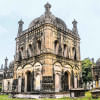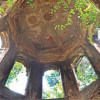A silent witness to Dhaka’s history
With falling leaves, worn-out epitaphs and gravestones, and rustle of breeze whispering tales from four centuries ago -- Dhaka Christian Cemetery, known to city dwellers as Narinda or Wari cemetery, has been the resting place of many known or unsung heroes for decades.
Established away from the chaos of Old Town, this graveyard bears witness to the rule of the Mughals and the British, the partition of 1947, the struggle for independence in 1971, and finally, Bangladesh's victory over Pakistan and its emergence as an independent nation.
Narrating tales of history and heritage through generations, more than one lakh people are currently resting on the green pastures of this cemetery, stretching across 6.5 acres of land.
Every year, around 50 others join the meadows to seek eternal peace, only to be remembered on special occasions and missed on lonely, gloomy nights, shared the cemetery's caretaker Shoumik Soren.

PEEKING INTO HISTORY, HERITAGE
At the entrance, a rugged board greets visitors. It says the cemetery was established in 1600.
Meanwhile, another board, still standing tall at a little distance, claims that the place was built in the 16th century.
The claims were validated by historian Muntassir Mamoon in his book "Dhaka: Smriti Bismritir Nagari".
According to Fr Anol Terence D'Costa, Dhaka attained its status as the capital of East Bengal in 1608.
Aiming to install the essence of Christianity among locals, Augustinian priests first stepped into this land in 1612 and established a church in 1628 for the newly-converted devotees in Laxmibazar's Narinda.
This was the fifth church in Bengal and the first of its kind in the metropolis.
However, the exact date of its establishment remains hidden in the lost pages of history.
The cemetery is currently run by Dhaka Christian Cemetery Board.
"Several epitaphs here date back to the 1600s. Though we do not know the exact time frame of the cemetery's establishment, undoubtedly, it's the oldest one in the capital," said Fr Albert Rozario, parish priest of St Mary's Cathedral and vice-chairman of the board.
ACCOUNT OF ABANDONMENT
Historians believe the cemetery was originally built as a church graveyard, designated to bury Christians.
"Adjacent to the burial ground, an Anglican church used to stand tall, known to people as Swarganwita Ranir Girja (Church of the Queen of the Heaven). However, the church is now defunct," shared Rozario.
According to his book "Bangladesh e Chirstodorma o Christomondolir Etikotha", the church was originally built in 1628 for Catholics, Armenian soldiers and English Christians living in Narinda and Phulbaria areas.
However, it later fell prey to natural calamities, and a lack of maintenance added to its decay.
According to the book, the annual report dated 1682 said Dhaka was home to 2,000 Christians, of whom 700 lived in Tejgaon. The population started to decline after the capital of Bengal was shifted to Murshidabad in 1703 and many relocated.
The church got abolished sometime between 1713 and 1789.

RELICS THAT REMAIN
Bishop Reginald Heber (1783-1826), an Oxford Anglican clergyman from England, visited the cemetery's consecration ceremony in 1824 during his 18-day stopover in Dhaka between July 4-22.
An account of the visit remains in the verses of his book titled, "Narrative of a journey through the upper provinces of India, from Calcutta to Bombay, 1824-1825".
"I consecrated the burial-ground; a wild and dismal place, surrounded by a high wall, with an old Moorish gateway, at the distance of about a mile front the now inhabited part of the city, but surrounded with a wilderness of ruins and jungle," reads a paragraph from the book.
A man of letters and hymns, the bishop also mentioned the tombs of Columbo Sahib, whose identity still remains a mystery, and Joseph Paget.
He also wrote of Wanxi Koya, a Chinese Christian who died on September 4, 1796, and was buried at the graveyard. According to historical accounts, his compatriot, Suhrid Wana Chou built his tomb.
Columbo Sahib's tomb, an architectural delight, not only remains as one of the most striking aspects of the cemetery in the verses of the bishop's book, but is also treasured in "Nagaphon Ghat", the oldest oil painting of Dhaka crafted by European artist Johann Zoffany in 1787.
Radiating the essence of Mughal architecture, the square-shaped tomb was designed embracing the structures of mausoleums, guided by four arched doors, one on each side.
Its two-storied dome, supported by octagonal pillars with the carvings of celestial angels, has several wall inscriptions -- all vague and rugged after combating the weather over the centuries.
While the pillars are still standing tall amid the overgrown bushes, the original structure of this tomb has deteriorated due to weathering.
Despite being the centre of attraction, the tomb fails to acquaint its visitors with Columbo Sahib as no one actually knows about his whereabouts.
"As far as I know, his original name is William Kerkman," mentioned Soren.
Heber, in this travelogue, also speaks about Sahib. One of the paragraphs from his books reads, "The old Durwan of the burial-ground said, it was the tomb of a certain 'Columbo Sahib, Company ka nuokur,' Columbo, servant to the Company; who he may have been I know not; his name does not sound like an Englishman's, nor is there any inscription."
Nevertheless, the tomb must have been built before Zoffany painted the piece in 1787, which means he must have died before that, mentioned Waqar A Khan, founder of Bangladesh Forum for Heritage Studies.
"There is such a large tomb in his name in the cemetery, but there is no mention of him anywhere. The fact that the tomb actually belongs to someone by this name also remains unverified," he said.
While no information has surfaced in this regard so far, the tomb was listed as a heritage site by the archeology department, added Fr Albert.

LEGENDS LAID TO REST
Taking a walk along the bushy walkways with Soren, this correspondent encountered an epitaph that dates back to March 26, 1724.
"The grave belongs to Joseph Paget, reverend minister of Kolkata. This is the oldest epitaph of the cemetery. The Directorate of Archeology has declared this grave as a protected heritage," said Soren.
In the middle of the cemetery lies a mass grave.
"Over a hundred martyrs of World War II were buried in this grave," mentioned Soren.
Nicholas Pogoz, founder of Pogoz School, was also laid to rest on these grounds.
Pogoz served as the headteacher of his school, the first private school in Dhaka, till 1855. He was also among the nine commissioners of Dacca Municipality during 1874–75 and a partner of Dacca Bank.
After walking for a while, this correspondent came across another tomb with a missing epitaph.

The grave belongs to Jeanette Van Tassel, the first to perform a manned balloon flight in Bangladesh on March 16, 1892.
Invited by Nawab of Dhaka Khwaja Ahsanaullah, Jeanette started her flight from the southern bank of the Buriganga, only to meet a tragic demise.
A deadly accident left Jeanette injured when she fell on the ground after flying over Ahsan Manzil for a while. She died at a hospital a few days later and was buried at this cemetery.
The cemetery is also the final resting place of two soldiers who lost their lives in the Sepoy Mutiny.
Of the two, the grave of soldier Henry Smith, who died on November 22, 1857, days after the first war of independence broke out, remains recognisable.
Displaying a stone statue of Mary, Jesus' mother, the tomb of Elizabeth, wife of Greek merchant Mercer David, also lies among stillness.
ONLY MASS OF THE YEAR
Adorning the hues of red, pink, yellow, and purple amid twinkling candles, this silent and decaying graveyard dresses in a new attire on the eve of November 2 every year.
Since abolishment of the church, mass is held here only once every year -- on the occasion of All Souls' Day, informed Sumon Francis Gomes, a local who often served as an altar boy at funerals at the cemetery.
"My two-year-old sister Scholastica lies buried here. So, we visit the cemetery at least once every year on the mass day to pray for her," said Sumon, who lost his sister to Diphtheria years ago.
It is one of the days that not only Christians but many in the city look forward to.
"The holy ambience, with the priest sprinkling holy water on the graves, the sweet smell of agarwood, the hymns, flower petals, and the blinking candle lights, not just calms the mind but is also a treat to the eyes," added Sumon.

RENOVATING THE CEMETERY
The Christian Cemetery Board is planning to renovate the cemetery, said Fr Albert.
A survey in this regard has already been done, and an appeal has been made to the government for funds.
The authorities plan to start the renovation work next year.


 For all latest news, follow The Daily Star's Google News channel.
For all latest news, follow The Daily Star's Google News channel. 





Comments